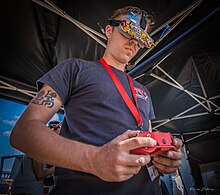First-person view (radio control)
More advanced setups commonly add in specialized hardware, including on-screen displays with GPS navigation and flight data, stabilization systems, and autopilot devices with "return to home" capability—allowing the aircraft to fly back to its starting point autonomously in the event of a signal loss.
This, when coupled with video goggles and "head tracking" devices creates a truly immersive, first-person experience, as if the pilot was actually sitting in the cockpit of the RC aircraft.
More complex Ground Stations often include a means to record the received image along with more sophisticated antennas for achieving greater range and clarity.
Fixed-wing aircraft are generally medium-sized with sufficient payload space for the video equipment and large wings capable of supporting the extra weight.
Multicopters, especially quadcopters, have fast been gaining popularity as agile camera platforms that can take high-quality video while hovering and maneuvering in tight spaces.
This increase in popularity has come about mainly due to new manufacturing techniques and a reduction in component costs, making this side of the FPV hobby more accessible to a wider audience.
In recent years, FPV Multirotor racing has become a very fast growing branch of the RC hobby, along with larger quads built for long range flight.
[4] Specialized long-range UHF control systems operate at 433 MHz (for amateur radio licensees only — especially with Switzerland having exclusive allocations for them, and secondary usage in much of North America)[6][7] or 869 MHz[4] and are commonly used to achieve greater control range, while the use of directional, high-gain antennas increases video range.
Hardware for this frequency is extremely cheap, does not require a license to use (under the specified dedicated bands and power outputs) and the antennae are relatively small, allowing for better portability.
[10] The ability of FPV aircraft to fly far beyond the visual range of the pilot and at significant altitudes above the surface has raised some safety concerns regarding risks of collisions with manned aircraft or danger to persons and property on the ground, causing some national aviation authorities to regulate or prohibit FPV flying.
Like all unmanned or remote aerial vehicle pilots there are a number of safety measures and laws that can be utilized, such as avoiding flying above populated areas or at high altitudes where manned aircraft are likely to be present, and utilizing autopilots with "return to home" capability which can automatically fly the aircraft back to its home location in the event of a signal loss.
[15] In this document, the FAA stated its position that model aircraft flown using FPV video goggles do not satisfy the definitional requirement in Sec.
"[15] In the long term, the FAA is developing regulations for small unmanned aircraft systems which may or may not impact FPV flight.
Though it has not so far pursued any enforcement actions related to use of amateur radio frequencies for commercial unmanned aircraft, the FCC has the authority to levy civil forfeitures and fines into the tens of thousands of dollars for violations of its regulations.
There are a wide variety of state and local laws and ordinances affecting model aircraft in general and FPV specifically.
All unmanned aeronautical activities in Australia are ruled by CASR (Civil Aviation Safety Regulations) Part 101[17] which includes sections for UAV's and model aircraft among other operations.







